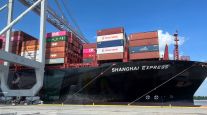Two Senators Propose New Import Fee as Part of U.S. Port Funding Overhaul
This story appears in the Aug. 26 print edition of Transport Topics.
Washington state’s two U.S. senators said they plan to introduce a bill next month to overhaul how the country collects and spends money to improve seaport freight infrastructure.
Democratic Sens. Patty Murray and Maria Cantwell said during a recent news conference that the current Harbor Maintenance Trust Fund neither collects enough revenue to fund needed projects nor spends enough of the money it collects.
The Harbor Maintenance Trust Fund receives its money from the Harbor Maintenance Tax collected from shippers importing goods at U.S. ports — something they’ve been able to avoid by going to Canada or Mexico instead and then bringing the goods into the United States by land, the senators said.
But a new Maritime Goods Movement User Fee would be collected at all U.S. points of entry any time freight is imported, they said, noting that this would increase the amount
of money collected and prevent shippers from avoiding fees.
“This legislation will change the Harbor Maintenance Tax to give shippers new incentives to move their goods through American ports, particularly those in the Pacific Northwest,” Murray said at an Aug. 15 news conference near the Port of Seattle.
“And it will double the amount of funds we can use to re-invest in our ports each year to keep them competitive in the global marketplace,” she added.
The Senate is on recess, but the senators plan to introduce their legislation when the recess ends in September, they said.
The Harbor Maintenance Trust Fund can only be used to maintain dredged navigation channels. But the fee the senators will propose would be available for a wider range of port infrastructure projects, they said.
In addition to a new fee and new collection mechanism, the bill would set aside a portion of the fund for remote or low-use ports that usually are at a disadvantage when competing with larger ports for funds.
The bill also would set aside funds for a competitive grant program to pay for highway and rail projects that help move freight past the ports, Murray and Cantwell said.
“Fixing the HMT is about giving businesses and workers in our trade economy tools to succeed in a global marketplace,” Cantwell said at the news conference. “Because we know that if the playing field is level, Washington’s state ports and products will win out.”
West Coast ports are at a funding disadvantage when compared with others, Cantwell said, because they do not generally require dredging as much as other ports. “So while Seattle and Tacoma generate 7% of the funds for the HMT, they only receive a penny for every dollar collected.”
Murray and Cantwell garnered support for their proposal from the Pacific Northwest Waterways Association, a group that represents port authorities in the region.
“Our association will definitely be supportive when the bill is introduced next month,” said Kristen Meira, executive director of the ports group. “This kind of approach will address all of the needs of ports in the Pacific Northwest, which are very diverse.”
By setting aside funding, the Murray and Cantwell proposal would particularly benefit small ports, including those in the lower Columbia River, Meira said.
But overall, the Harbor Maintenance Trust Fund is underused, Meira said. Only about half of what is collected every year is spent, and the federal government uses the rest to mask part of its deficit each year, she said.
“Funds are being collected but not spent for their intended purpose. All the while, you have navigation channels that are silting in, you have jetties that are crumbling,” she said. “This impacts the ability of our economy to have a revived economy, and it impacts the ability of our growers and manufacturers as they attempt to compete in an international marketplace.”
Leslie Blakey, executive director of the Coalition for America’s Gateways and Freight Corridors, agreed that the Harbor Maintenance Trust Fund should change. She called it a “very, very restrictive” fund that can only be used to maintain channels, and not even to increase their depth.
“The issue of keeping your deal with the users, using the money for what it was intended for and fully using is not too much to ask,” she said. “You have to answer that question before even getting to the issue of expanded uses.”




